Are you having trouble controlling thrips in greenhouses?
In some greenhouses, western flower thrips are becoming more difficult to control due to high levels of resistance to some insecticides. Be sure to always rotate the modes of action of pesticides.
Some growers are reporting infestations of western flower thrips where scouts are finding up to 400 thrips on sticky cards in a week. Despite spraying once or twice a week, thrips are still a problem in the greenhouse. A grower recently asked, “Why are these insecticides no longer effective for western flower thrips?” Unfortunately, some populations of thrips are becoming resistant to certain insecticides.
In March of 2013, Michigan State University Extension surveyed growers and four greenhouses reported that spinosad (Conserve) was no longer working for them while two greenhouses reported that abamectin (Avid) was not effective. In 2013, MSU’s Dave Smitley and David Mota-Sanchez did insecticide bioassays of four active ingredients on populations of thrips from MSU research greenhouses and commercial greenhouses in Michigan. They found that populations of thrips from MSU were more highly resistant to spinosad (Conserve) and acetamiprid (Tristar) than the populations of thrips from commercial greenhouses (Fig. 1). Other populations from commercial greenhouses, denoted by M1 and P1, were resistant to dinotefuran (Safari) and abamectin (Avid) (Fig. 2).
Figure 1. Levels of resistance of thrips populations from MSU research greenhouses and commercial greenhouses (M1 and P1) to products containing spinosad and acetamiprid.

Courtesy of Yinxue Mao, David Mota-Sanchez, David Smitley and Mark Whalon
Figure 2. Levels of resistance of thrips populations from MSU research greenhouses and commercial greenhouses (M1 and P1) to products containing dinotefuran and abamectin.

Courtesy of Yinxue Mao, David Mota-Sanchez, David Smitley and Mark Whalon
In Figures 1 and 2, the “resistance ratio” represents the insect’s level of resistance to a particular active ingredient. In other words, it represents how much more of an insecticide would be necessary to kill at least 50 percent of a resistant population compared to 50 percent of a susceptible population. To prevent resistance of insects in your greenhouse, be sure to rotate the modes of action of your insecticides.
For this growing season, MSU Extension recommends the following products for thrips control:
- Aria
- Distance
- Hachi-Hachi (do not use on impatiens or New Guinea impatiens)
- Mesurol
- Orthene 97
- Overture
- Pedestal
- Pylon
- Sanmite
For those still struggling with thrips, consider using biological control for thrips next season. For more information, read “Four critical steps to implementing a biological control program” and “Timing the release of beneficials is critical to biocontrol success.”



 Print
Print Email
Email


